外研版必修三Module 2 Developing and Developed Countries introduction, reading & vocabulary课件(27张ppt)
文档属性
| 名称 | 外研版必修三Module 2 Developing and Developed Countries introduction, reading & vocabulary课件(27张ppt) | 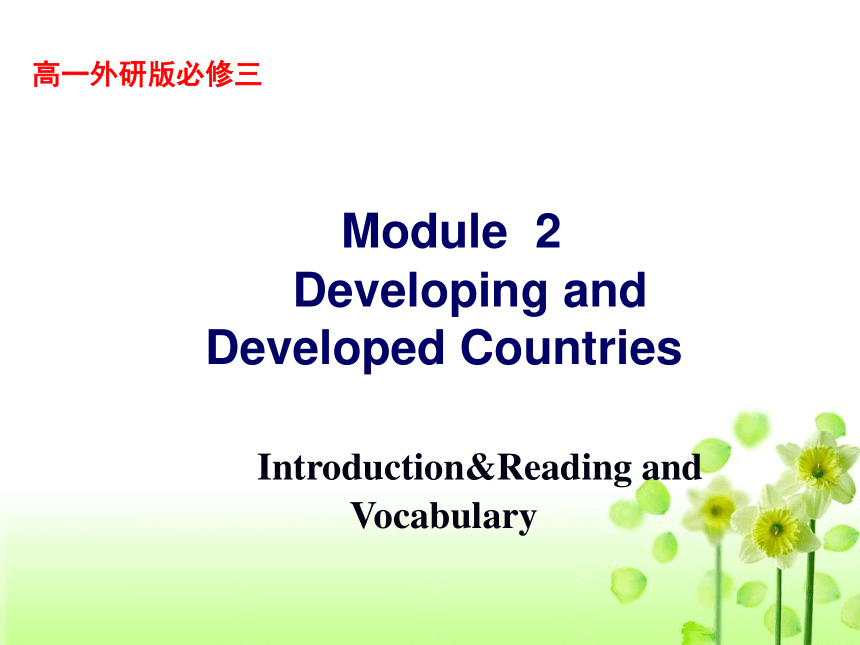 | |
| 格式 | zip | ||
| 文件大小 | 1.4MB | ||
| 资源类型 | 教案 | ||
| 版本资源 | 外研版 | ||
| 科目 | 英语 | ||
| 更新时间 | 2019-12-26 21:01:36 | ||
图片预览


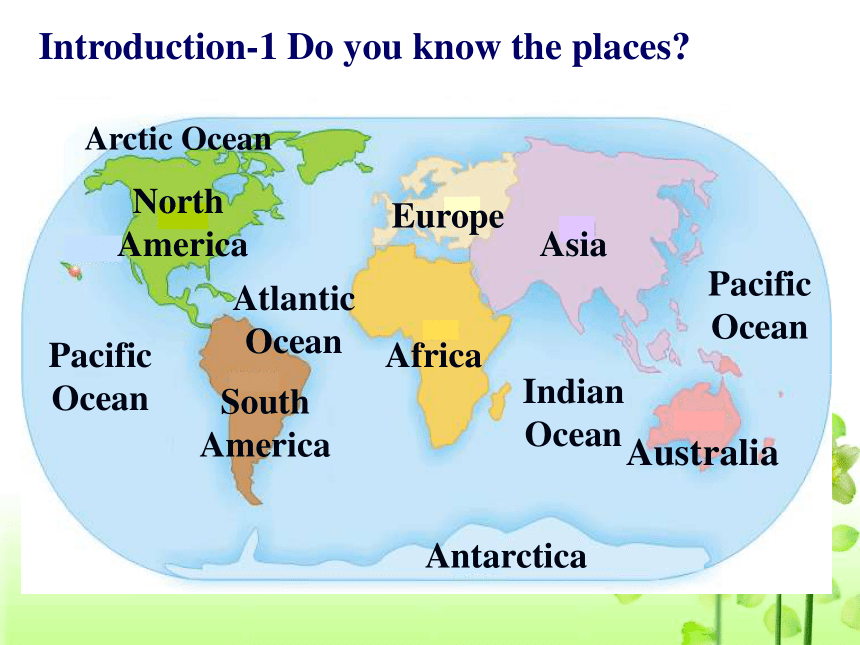
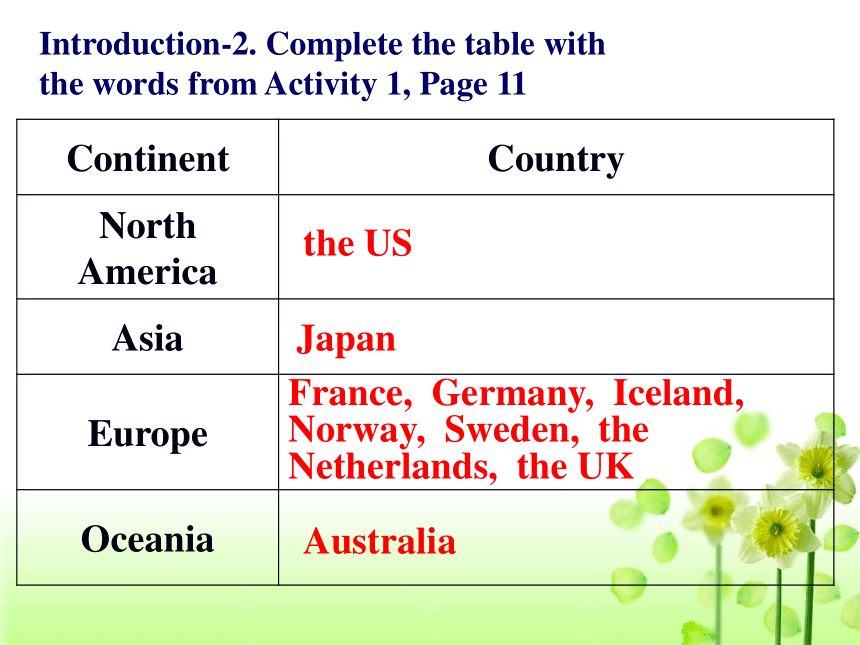
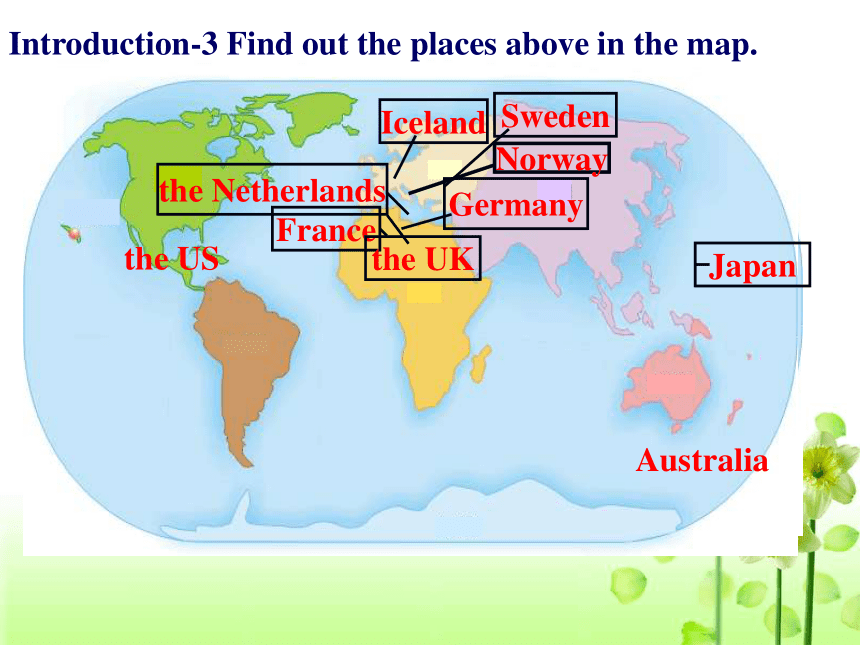
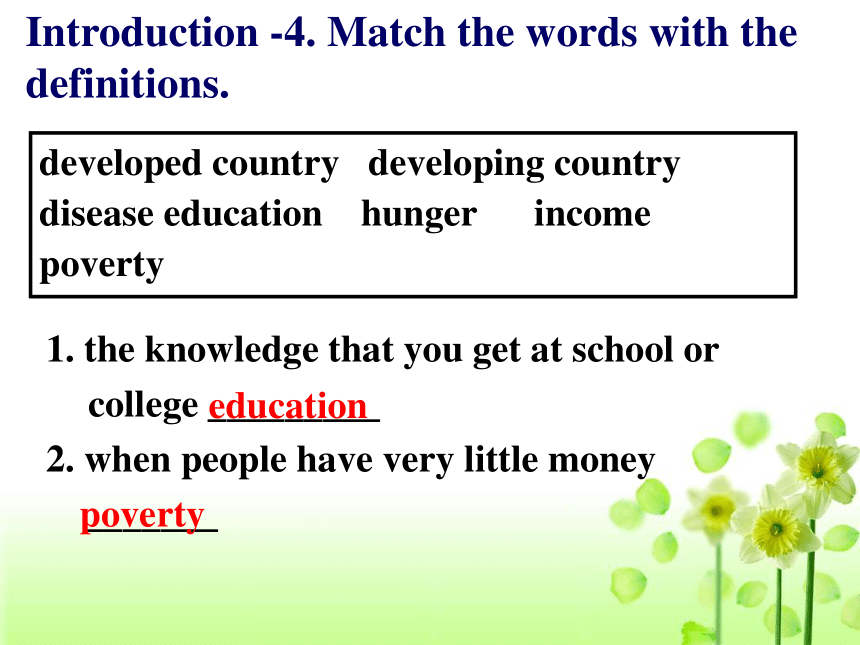
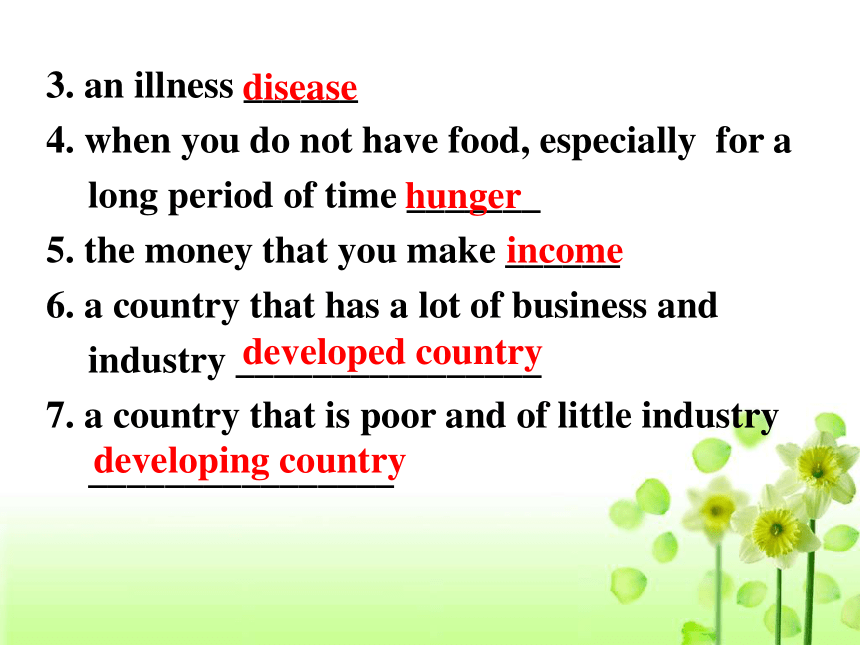
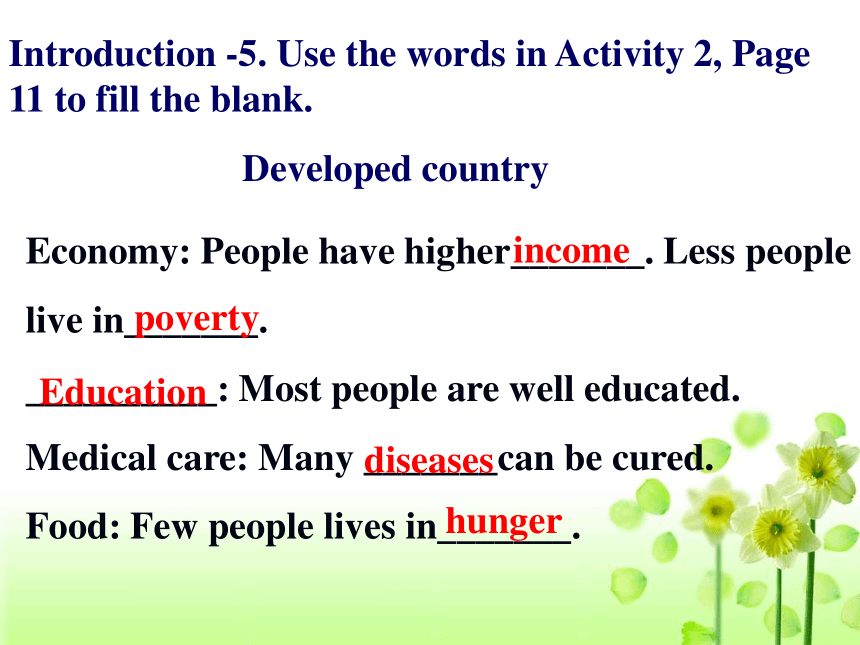
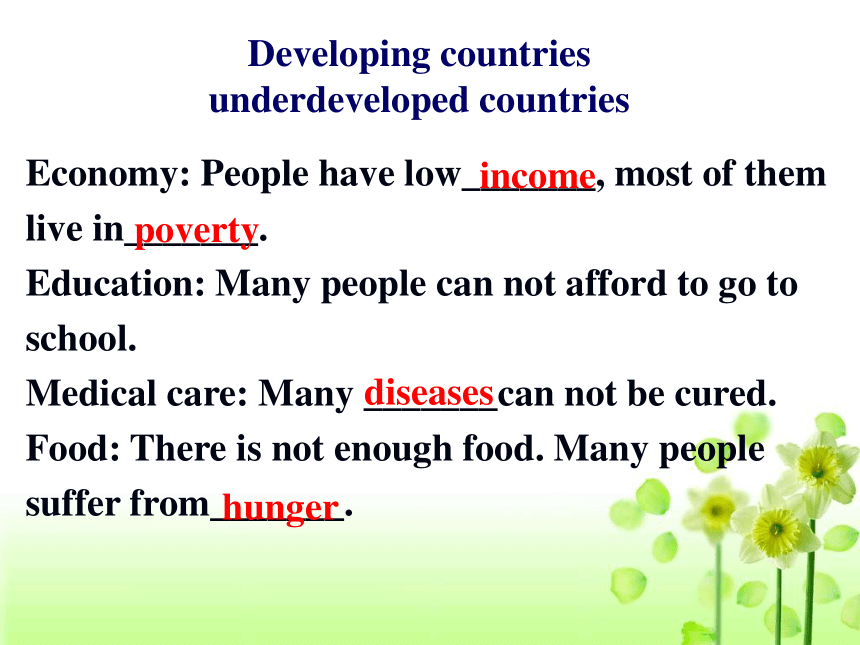
文档简介
(共27张PPT)
高一外研版必修三
Module 2
Developing and Developed Countries
Introduction&Reading and Vocabulary
Introduction
Asia
Australia
Europe
Africa
North
America
South
America
Antarctica
Arctic Ocean
Pacific
Ocean
Atlantic
Ocean
Indian
Ocean
Pacific
Ocean
Introduction-1 Do you know the places?
the US
Japan
France, Germany, Iceland, Norway, Sweden, the Netherlands, the UK
Australia
Introduction-2. Complete the table with
the words from Activity 1, Page 11
Continent Country
North America
Asia
Europe
Oceania
Australia
the US
Introduction-3 Find out the places above in the map.
1. the knowledge that you get at school or college _________
2. when people have very little money
_______
education
poverty
developed country developing country disease education hunger income poverty
Introduction -4. Match the words with the
definitions.
3. an illness ______
4. when you do not have food, especially for a long period of time _______
5. the money that you make ______
6. a country that has a lot of business and industry ________________
7. a country that is poor and of little industry ________________
hunger
income
developed country
developing country
disease
Developed country
Economy: People have higher_______. Less people live in_______.
__________: Most people are well educated.
Medical care: Many _______can be cured.
Food: Few people lives in_______.
income
poverty
Education
diseases
hunger
Introduction -5. Use the words in Activity 2, Page
11 to fill the blank.
Developing countries
underdeveloped countries
Economy: People have low_______, most of them live in_______.
Education: Many people can not afford to go to school.
Medical care: Many _______can not be cured.
Food: There is not enough food. Many people suffer from_______.
income
poverty
diseases
hunger
Reading and Vocabulary
Pre-reading Look at the pictures and discuss
why we should help developing countries and
how we could do it
1. What did world leaders agree to do in
2000?
They agreed to reduce world poverty by
2015 or earlier.
2. What does the Human Development
Index measure?
It measures a country’s achievements.
Reading & Vocabulary –1. Read the passage,
then answer the questions at Activity 1, Page 12.
3. What are the first two Development
Goals?
To reduce poverty and hunger, and ensure
all children are educated up to the age of
11.
4. What progress have we made towards
these goals?
They need to give more money.
5. What do developed countries need to do?
There are some examples of successful
development, like in china, but more effort
is needed.
Norway
the US
the UK
Sierra Leone
Reading & Vocabulary –2. Finish the exercise
at Activity 2, Page13.
Top of the list
Number 7
Number 13
Bottom of the list
13 years
150 million
799 million
115 million
1 billion
Reading & Vocabulary –3 Fill the form.
Increse in life expectancy
in China (1953-1962)
the number of people moved out of poverty in China
(1993-2003)
the number of hungry people in developing countries
the number of children not receiving education in developing countries
the number of people without safe water in developing countries
Fact Figure
How the Human Development Report came out.
The H.D Index measures a country’s achievement.
The most five important goals of the report.
Examples of successful development in 2003
Developed countries should give more financial help
Reading & Vocabulary –4. Find out the main idea of
each paragraph.
Main idea
Para. 1
Para. 2
Para. 3
Para. 4
Para. 5
Reading & Vocabulary –5. Read the text
carefully and decide whether the following
statements are true (T) or false (F).
In 2000, 147 world leaders agreed to
work together to reduce poverty after
2015.
2. Life expectancy means that how
long a person usually lives in the world.
F
T
3. Every day, nearly 400 million people in South Asia or Africa are hungry.
4. The Human Development Report came
from the Index.
5. The top five countries on the list are all
from Europe while the bottom 10
countries are all African countries.
T
F
F
Collect more information on Internet about one of the problems of developing countries.
Examples:
hunger
poverty
education
disease
Homework
高一外研版必修三
Module 2
Developing and Developed Countries
Introduction&Reading and Vocabulary
Introduction
Asia
Australia
Europe
Africa
North
America
South
America
Antarctica
Arctic Ocean
Pacific
Ocean
Atlantic
Ocean
Indian
Ocean
Pacific
Ocean
Introduction-1 Do you know the places?
the US
Japan
France, Germany, Iceland, Norway, Sweden, the Netherlands, the UK
Australia
Introduction-2. Complete the table with
the words from Activity 1, Page 11
Continent Country
North America
Asia
Europe
Oceania
Australia
the US
Introduction-3 Find out the places above in the map.
1. the knowledge that you get at school or college _________
2. when people have very little money
_______
education
poverty
developed country developing country disease education hunger income poverty
Introduction -4. Match the words with the
definitions.
3. an illness ______
4. when you do not have food, especially for a long period of time _______
5. the money that you make ______
6. a country that has a lot of business and industry ________________
7. a country that is poor and of little industry ________________
hunger
income
developed country
developing country
disease
Developed country
Economy: People have higher_______. Less people live in_______.
__________: Most people are well educated.
Medical care: Many _______can be cured.
Food: Few people lives in_______.
income
poverty
Education
diseases
hunger
Introduction -5. Use the words in Activity 2, Page
11 to fill the blank.
Developing countries
underdeveloped countries
Economy: People have low_______, most of them live in_______.
Education: Many people can not afford to go to school.
Medical care: Many _______can not be cured.
Food: There is not enough food. Many people suffer from_______.
income
poverty
diseases
hunger
Reading and Vocabulary
Pre-reading Look at the pictures and discuss
why we should help developing countries and
how we could do it
1. What did world leaders agree to do in
2000?
They agreed to reduce world poverty by
2015 or earlier.
2. What does the Human Development
Index measure?
It measures a country’s achievements.
Reading & Vocabulary –1. Read the passage,
then answer the questions at Activity 1, Page 12.
3. What are the first two Development
Goals?
To reduce poverty and hunger, and ensure
all children are educated up to the age of
11.
4. What progress have we made towards
these goals?
They need to give more money.
5. What do developed countries need to do?
There are some examples of successful
development, like in china, but more effort
is needed.
Norway
the US
the UK
Sierra Leone
Reading & Vocabulary –2. Finish the exercise
at Activity 2, Page13.
Top of the list
Number 7
Number 13
Bottom of the list
13 years
150 million
799 million
115 million
1 billion
Reading & Vocabulary –3 Fill the form.
Increse in life expectancy
in China (1953-1962)
the number of people moved out of poverty in China
(1993-2003)
the number of hungry people in developing countries
the number of children not receiving education in developing countries
the number of people without safe water in developing countries
Fact Figure
How the Human Development Report came out.
The H.D Index measures a country’s achievement.
The most five important goals of the report.
Examples of successful development in 2003
Developed countries should give more financial help
Reading & Vocabulary –4. Find out the main idea of
each paragraph.
Main idea
Para. 1
Para. 2
Para. 3
Para. 4
Para. 5
Reading & Vocabulary –5. Read the text
carefully and decide whether the following
statements are true (T) or false (F).
In 2000, 147 world leaders agreed to
work together to reduce poverty after
2015.
2. Life expectancy means that how
long a person usually lives in the world.
F
T
3. Every day, nearly 400 million people in South Asia or Africa are hungry.
4. The Human Development Report came
from the Index.
5. The top five countries on the list are all
from Europe while the bottom 10
countries are all African countries.
T
F
F
Collect more information on Internet about one of the problems of developing countries.
Examples:
hunger
poverty
education
disease
Homework
